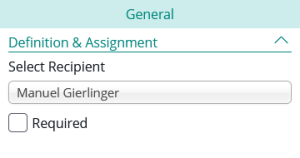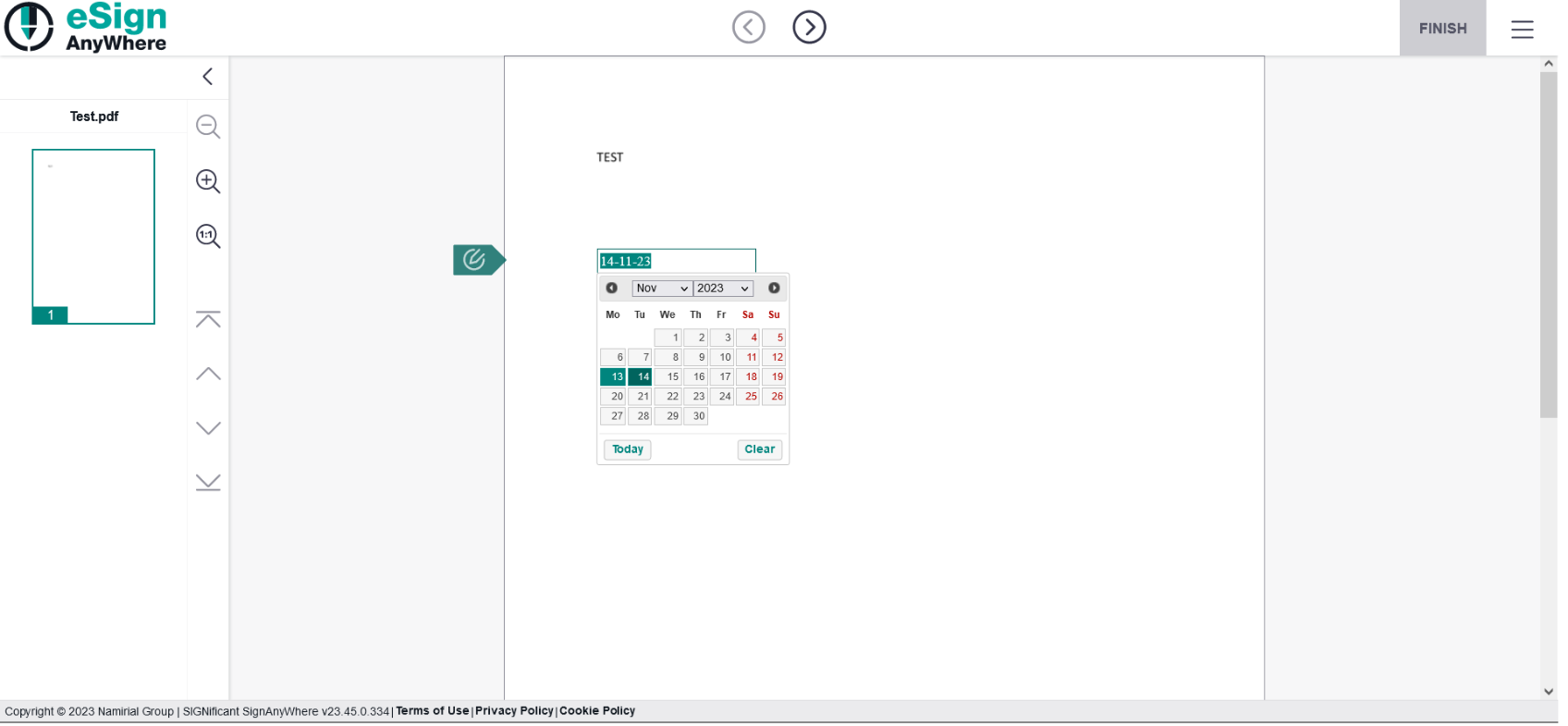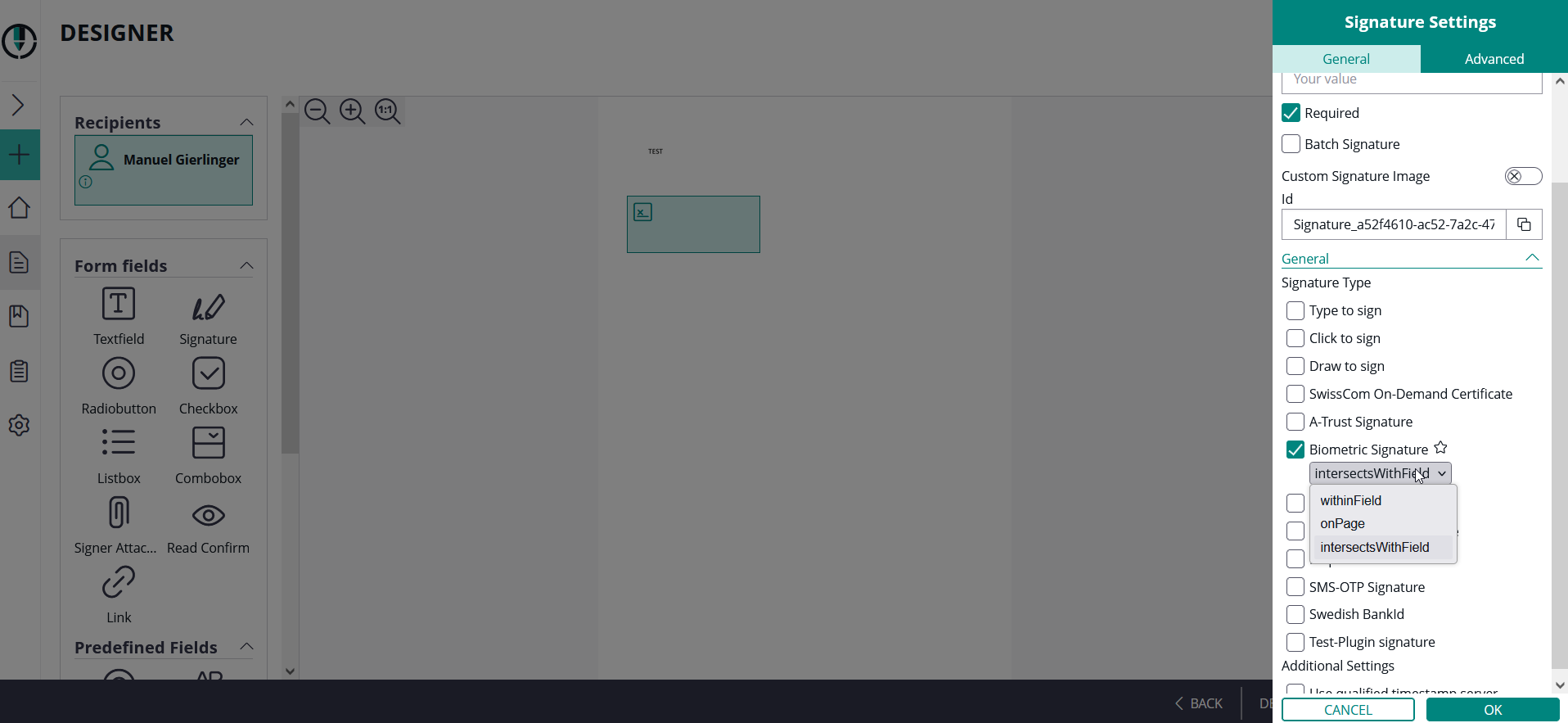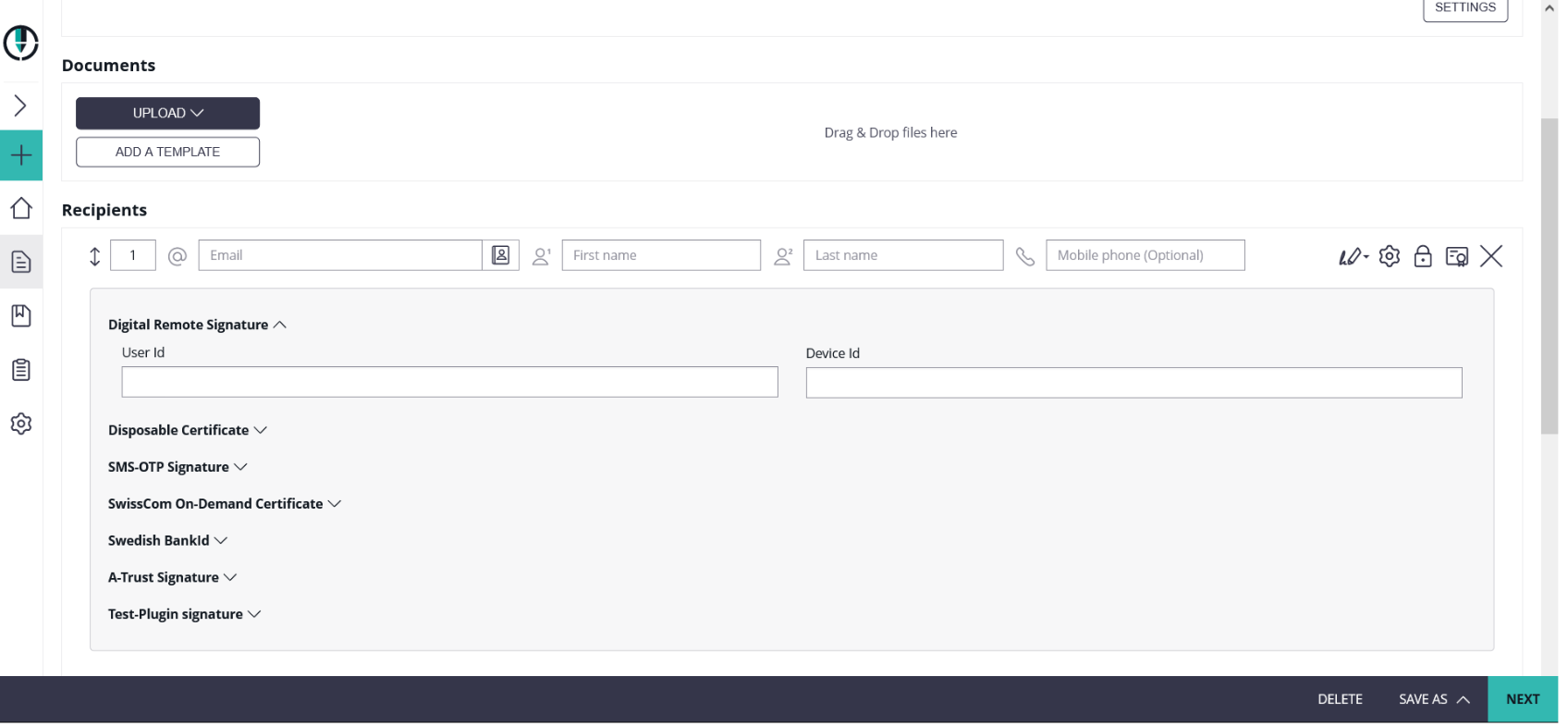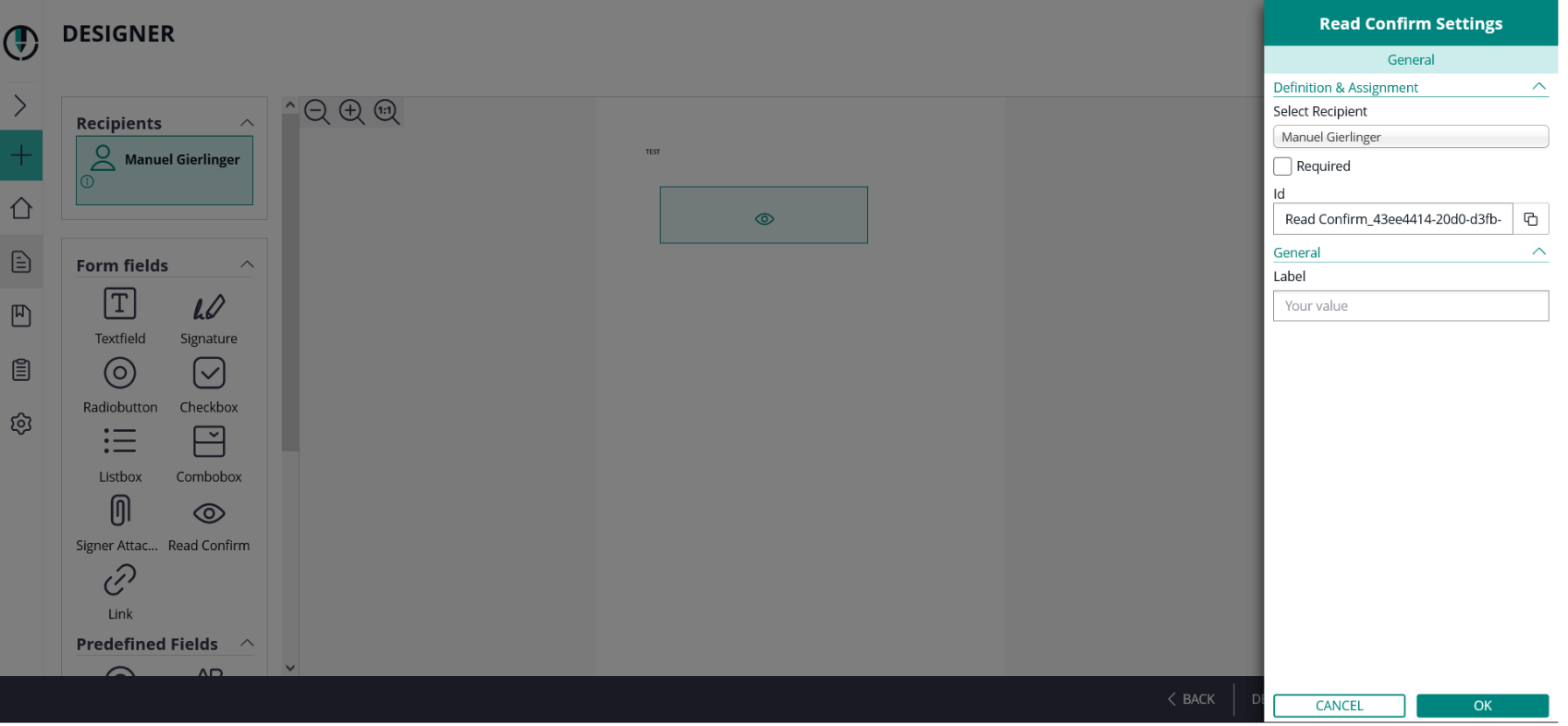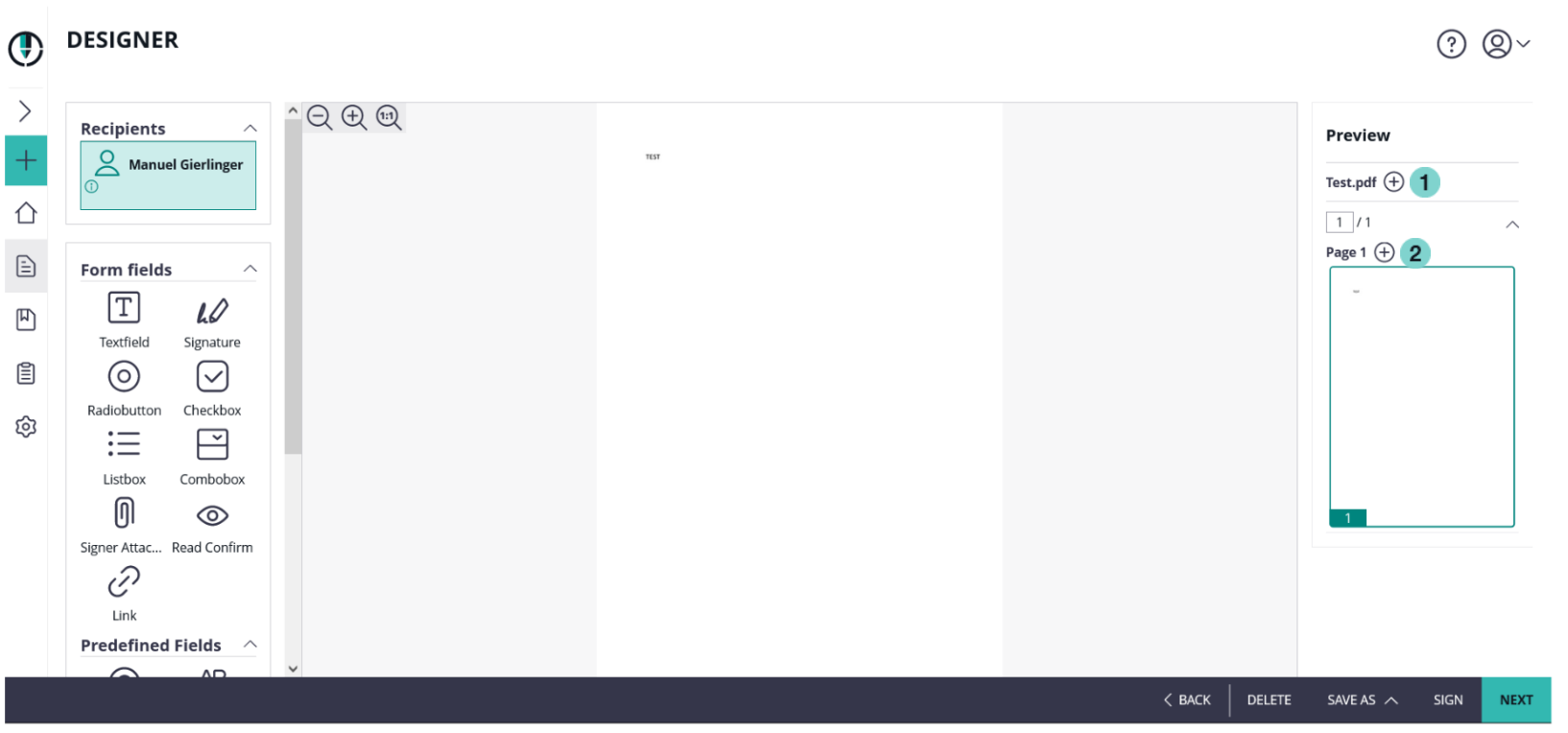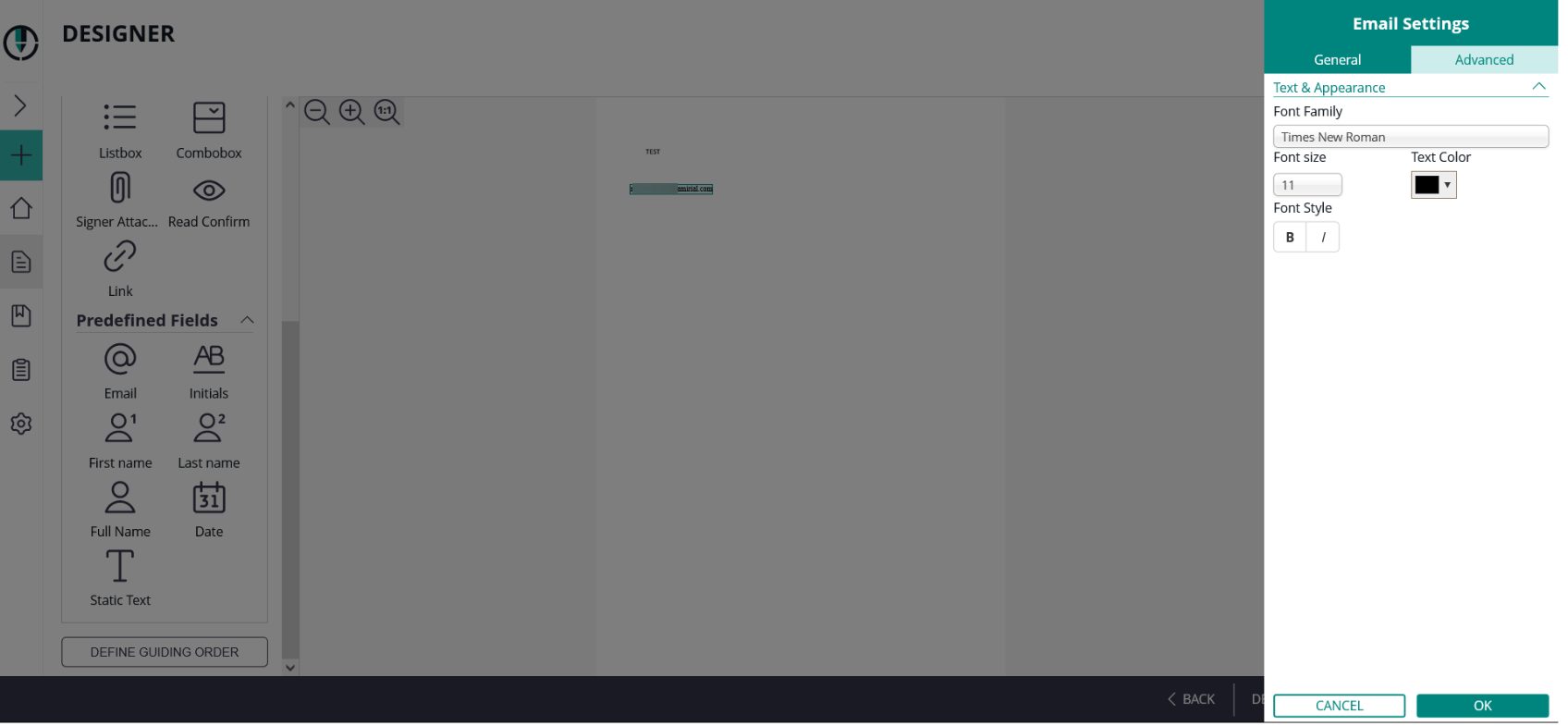The designer page shows all formerly added (or recognized) interactive fields on the documents and allows to interactively place additional interactive fields.
Please see the following figure for more information.
| Figure | Description |
|---|---|
Properties Panel |
This documentation covers the following topics in the next chapters:
UI Areas of the Designer explained in Detail
In this chapter, we are explaining the UI elements and their behavior in detail.
Standard Menu Bar
- new Document: create a new document
- Home: to go back to the main page
- Documents: your (or our teams) sent documents and documents you have to sign
- Templates: your available templates
- Clipboard: if you install the MS Office Plugin (available in the menu top right), you are able to directly upload documents to MS Word to your clipboard in eSignAnyWhere.
- Settings: change your account or organization settings
For more information about the menu bar please also have a look at the Application Reference Web UI guide.
Recipients List
Shows the list of all recipients and automatic-signature activities.
Allows to select to which recipient elements that are added later-on are assigned, and can be used to re-assign the element currently selected in the Main Editor. Just switch between the recipients to assign the tasks for them.
Form Field Elements
Please note: It is not possible to add any form fields (except signer attachments and signature fields) to an already signed document.
Let's have a deeper look into the properties of the elements which you can place using the Designer Page. When an element was placed on a document, and the element gets selected, the properties panel gets opened. Within the properties panel, different properties of the element can be defined. The properties which can be defined vary between different element types.
Note that not all of the properties explained below are available on all instances or in all organizations. Some may require additional contractual agreements, may depend on instance configuration, or on Feature Flag configuration. In case you are missing a feature described below in your organization, and you need the functionality for your business case, get in contact with your Namirial Sales Representative or Technical Account Manager.
General properties of all Elements
There is a couple of properties which can be defined on any interactive element that can be placed on a document:
The assignment of an element to a recipient defines which recipient is allowed to, or must, fill an element as part of fulfilling the (signing) activity. An element can be assigned to one (or no) recipient. Only recipients of type "signer" (with or without having signature fields) are eligible in the recipients selection (with an exception - "Automatic Signing Activities" can be selected on signature fields, see below). If a field is not assigned to any recipient, only the default value will be shown to all signers (and other recipients), but nobody will be able to interact with the element or change its value. When changing the recipient using the drop down list, both the color indicator of the properties panel and the color of the element in the main panel will automatically change to the color indicator of the recipient (also visible e.g. in the recipients panel).
Only the recipient to whom an element was assigned will later-on be able to edit the value, but also all the other recipients in the signature workflow will see the value. Recipients that are involved in an activity before the signer is setting/editing the value see the field's default value (which might be empty or changed afterwards), while recipients that are involved after the signer see the value which the signer finally set.
Also, all elements support to define if an element is "required" or "optional". "Required" means that the user to whom an element is assigned must set a value (or keep the initial value), to ensure the element's value is not empty. Some field types like checkboxes may define different policies for handing the "required" property; we will explain details below in the properties section of the respective field types..
Textfield
Following settings are available for textfields:
| General | Advanced |
|---|---|
|
|
It is possible to add a validation for the text field. You can choose between the following validations:
- None
- Date
- Format
- Minimum value
- Maximum value
- Number
- Decimal Places
- Symbol
- Symbol location
- Group Separator
- Decimal Separator
- Minimum value
- Maximum value
- Phone
- Phone type
- international
- international leading zeros
- international leading plus
- Phone type
- Time
- Format
- Minimum value
- Maximum value
Please see the following sample for date validation:
| Input validation | Result |
|---|---|
Signature
For information about how to sign the different signature types please have a look at the Signer Guide.
For information about how to configure the signature types for a REST api call please have a look at: Beginner Guide
In the "General" section, the signer can select the signature type(s) he wants to allow for the signer. The different signature types are explained in detail in the Electronic Signature Guide (sender perspective). Also, the Signer Guide describes the different user experience from signer's perspective.
If the sender allows just one signature type, the signature type will be automatically selected when a recipient later-on clicks on the signature field. When allowing multiple signature types, the sender is allowing the recipient to select one of the allowed signature types. The sender can in addition define, by marking the "star" icon (), a preferred signature type which is then automatically preselected for the recipient.
In addition, the sender can define if a timestamp of a time-stamping service will be embedded on the signature directly.
The (RFC 3161 compliant) timestamp service therefore has to be configured in the server configuration. It depends on server configuration, if a qualified timestamp service will be used therefore.
Please see the following settings which are available for all signature fields:
The "Definition & Assignment" section behaves like defined in the standard behavior of all elements, but with following deviations:
- Signature fields can be assigned also to "Automatic Signing Activities", making the automatic signatures visible on the document
- Required
- Custom Signature Image (feature flag necessary: "ExternalSignatureImage"
- This allows signers to upload their picture (custom signature picture) and add it as additional graphics to the stamp imprint. Furthermore the signer can store the signature image which a gallery for later usage.
- By enabling the "Custom Signature Image" checkbox, the sender can allow (or enforce) that the signer is uploading an additional image to be shown in the signature field. Such custom signature images can be used to ask for placing a company stamp picture, or to insert Hanko stamps. See Story: Using external signature images for additional use case details. Note that the global setting here sets and overrules the signature-type specific settings, as this property can also be defined on a per-signature-type level in the Advanced tab.
- Batch Signature
With the "Batch Signature" checkbox enabled, it makes the signature field a member of a batch of several signature fields. Signatures being member of a batch can be signed all at once if the signer prefers, but allow the signer also to sign them one by one. When the batch signing option is enabled, the sender can distinguish between different batch signing behavior:
- Simple Batch
where the signer just knows how many signature fields are signed as part of the batch - Signature List (unselected)
where a list of all signature fields (document name and page number, or signature field label) are displayed in a list of checkboxes; the user needs to select those which should be signed as part of the batch (opt-in) - Signature List (preselected)
where a list of all signature fields (document name and page number, or signature field label) are displayed in a list of checkboxes; the user can deselect those which she/he doesn't want to sign as part of the batch (opt-out) - Signature List (selected, required mandatory)
Like "preselected", but without an option to uncheck the "mandatory signature fields) - Signature List (unselected, required mandatory)
Like "unselected", but mandators signature fields still preselected and without an option to uncheck the mandatory signature fields
- Simple Batch
The signature field, in the designer page's main editor, is represented by a different icon when the signature field is member of a batch:
Signature Field in standard representation Signature Field allowing batch signing
Following options available for all signature types
In the section "Display following stamp imprint data", the sender can define which data to be contained on the signature representation on the PDF. Note that some items will be ignored when defining a custom stamp imprint configuration that simply does not contain a specific field for all or some signature types.
The following default values are used for all signature types:
Please note: If "Extra Information" is disabled, all other variables (such as "Name", "IP address" etc.) will be automatically disabled as well and no information will be displayed as stamp imprint.
- Signature rendering
- custom signature image: false
- Stamp imprint settings
- Extra information: true
- Email address: true
The signer's mail address, automatically filled with the information available on the activity. - Transaction Id: true
- Transaction token: true
- Phone number
Automatically filled with the information available on the activity, when applicable. Always printed in the international format with country prefix (e.g. +39 or +43) - IP address: true
- Name: true
the full name (given name and family name) of the signer, automatically filled with the information available on the activity. - Signature date: true
- Font name: Configured organization default is used
- Font size: Configured organization default is used
- Exceptions for Draw2Sign:
- "Extra Information", "Display Email Address", "Display IP Address", "Display Name", "Display Signed on Date" is used from the organization default settings (configurable in the Organization dialog under "Extended settings for 'Draw to sign')
The "Advanced Settings" tab allows to set additional parameters.
At the top of the advanced settings, the sender can change the appearance of the signature rendering:
- Define the date format used for rendering the date on a signature field
(this configuration will be ignored when defining a specific date format in a custom stamp imprint configuration that is applied organization wide for all or some signature types)
As many settings are different per signature type, the advanced settings tab also lists all signature types which have been allowed on the General tab. For each of the signature types, a settings section (which is by default collapsed) can be expanded. Some of these settings can be defined per signature type, but same options are available for all signature types to allow independent configuration.
UI signature validity in second. This setting is used by the following sigTypes:
- DisposableCertificate
- SwissComOnDemand
- RemoteCertificate
- OneTimePassword
ClickToSign
Please note: The additional setting for using qualified timestamp server is not available for this signature type.
There is no additional configuration (setting) needed for this signature type.
This is the simplest signature type, with the most convenient user experience. With this signature type the signer has just to click on the signature field to sign. As it is a pure browser-based signing experience, we consider the "ClickToSign" signature type as one of the "HTML5 signature types". This requires careful consideration of configuration of the activity to reach the necessary expression of power.
DrawToSign
Please note: The additional setting for using qualified timestamp server is not available for this signature type.
There is neither an additional configuration (setting) nor a feature flag needed for this signature type.
This type allows the signer to draw his signature by mouse, finger or pen. Just an image of his signature is created and embedded into the document. In this case, only the flat picture of the signature and technical parameters of the session are recorded, but no biometric data. We consider also the "DrawToSign" signature type as one of the "HTML5 signature types".
TypeToSign
Please note: The additional setting for using qualified timestamp server is not available for this signature type.
There is neither an additional configuration (setting) nor a feature flag needed for this signature type.
With this type the signer has to type in his name to sign the signature field. The signature itself is printed in a computer font that may look like someone's handwriting, but actually isn't the signer's handwriting itself. It's the third and last one of this guide which we consider as one of the "HTML5 signature types".
SwissCom On Demand Certificate
Following feature flag is necessary: SwissComOnDemandCertificate
Before starting the envelope please see the following configurations which are needed in order to send a SwissCom On Demand Certificate.
| Figure | Configuration |
|---|---|
|
Name pattern
Please see the following sample name pattern (can differ in other use cases):
Please also note that the name patterns are case sensitive!
cn=TEST ##ReceiverFirstName## \n##ReceiverLastName##, givenname=##ReceiverFirstName##, \nsurname=##ReceiverLastName##, c=##country##, \nemailaddress=##ReceiverEmail##
If an evidenceId is needed add it to the pattern like it is shown in the next sample and enable the checkbox "Determine and set Swisscom On-Demand Certificate 'Evidence ID' automatically:
cn=TEST ##ReceiverFirstName## \n##ReceiverLastName##, givenname=##ReceiverFirstName##, \nsurname=##ReceiverLastName##, c=##country##, \nemailaddress=##ReceiverEmail##, serialNumber=##EvidenceId##
After setting the organization configuration you can start with the envelope. Please do not forget to add the following data which is necessary to use the SwissCom On Demand Certificate:
| Figure | Configuration |
|---|---|
|
Biometric Signature
On a signature field which allows recording a biometric signature, the biometric verification can be enabled in case the (optional) SIGNificant Biometric Server was also installed and properly configured.
When enabling the biometric verification, the sender has to provide the signer's user ID which was used to enroll a profile.
The sender can configure behavior of the biometric verification:
- It is possible to allow to skip the verification (in case the matching score is below the required threshold).
- The signature field can be configured to allow enrolling signatures to a profile if there have not been enough signatures enrolled to the profile yet.
Another option allows the sender to define that only the validation response (which includes the validation score obtained from biometric server) should be stored in the signed PDF, instead of storing the entire biometric data. In this case, the document itself does not store the data required for a forensic examination of the handwritten signature, but legal considerations may result in preferring that option, in some countries.
Following feature flag is necessary: BiometricSignature
For the biometric signature you can additionally configure following setting:
- positioning
- intersects with field
- withinField
- onPage
Local Certificate
For a local certificate signature, the sender can define filters on certificates to be offered for signing. Currently it is possible to define a preferred signature algorithm. Certificates using this algorithm will be ranked higher in the certificates offered to the signer.
The sender can also enforce to use the selected (preferred) one, which avoids that the signer is using certificates based on another (probably weaker) digital signature algorithm. You can enable preferred hash algorithm and enforce the use of the chosen algorithm. The enforce shown algorithm will be dynamically changed if the preferred algorithm is changed.
Please see the following configuration available for local certificate signature:
Figure | Configuration |
|---|---|
|
Digital Remote Signature
If the user has a long lived certificate you can use the Digital Remote Signature option. You can configure the User Id and the Device Id. If not configured the signer must provide those information:
Disposable Certificate
Disposable certificate advanced settings now also contains the option to select a long lived certificate. You can also force this setting in the organization settings.
The Long-Lived Disposable Certificate (LLD) is a special variant of a Disposable certificate. The main difference is, that it is not being activated immediately, but after the signatures have been applied.
The Long-Life Disposable certificate profile allows to manage the Qualified Certificate issuance in restricted use-cases restricted to closed-group users contexts, where digital signatures do not produce any legal effect if the verification of the certificate holder identity is not completed with a positive result.
A typical use case is when the document to be signed is a contract that needs to be executed by two or more parties and it does not carry any legal effect until all parties have signed it.
Following feature flag is necessary: DisposableCertificate
Please see the following configuration for the disposable certificate (those settings can be found in the organization settings)
| Figure | Configuration |
|---|---|
|
After the configuration in the organization settings you also have to fill in the disposable data for the recipient. Please see the next figure:
| Figure | Configuration |
|---|---|
|
The signer will receive its email as usual and when the signer wants to sign a disposable certificate signature field he will get a one-time-password via SMS. The counter on the disposable certificate starts by signing the first signature. If “Show disclaimer before certificate request” is enabled in Settings->Organization->Disposable Certificate the signer first receives the disclaimer before the SMS-OTP. When the document is finished you can validate, for example, the qualified electronic signature in Adobe Reader.
SMS-OTP Signature
Following configuration (optional) can be set before sending the envelope with a SMS-OTP signature: You can either set the phone number for the signer or not. To set the phone number just add in the following space on the create envelope page. If you do not set the phone number, the signer has to fill in his/her phone number:
Automatic Remote Signature
Following feature flag is necessary: AutomaticRemoteSignature
If you create a workflow, a new type “Add Automatic” recipient is available. The automatic remote signature / eSealing is applied automatically to the document, if it is the automatic recipient turn. The workflow continues automatically with the next recipient after the automatic recipient.
- Automatic Remote Signatures / eSealing are an optional eSignAnyWhere feature
- User Managers can configure the automatic remote signature / eSealing profiles in the Organization settings page, when they have enabled the user option “Allow Automatic eSealing”
- Power use can use the automatic remote signature / eSealing profiles, if they have the user option “Allow Automatic eSealing” enabled
1) Automatic Remote Signature Profiles
The profiles for automatic remote signatures are managed via the organization’s settings page (so only by user managers). For creating an automatic remote signature profile you need a description (e.g. name), the username and the password.
Attention: if a power user wants to use the automatic remote signatures, the user must have enabled the user right “” (see “Settings” > “Users”).
2) User Settings
User must have enabled the option “Allow automatic eSealing” to use the automatic remote signatures / eSealing within a workflow.
|
3) Creating a workflow with automatic remote signatures
In the eSAW UI you can add an automatic signer / eSealing via button in the recipient list “Add Automatic”. Then the profile must be selected for the automatic signature / eSealing. Attention: the power user must have the right “Allow automatic eSealing” enabled (see “Settings” > “Users”).
|
Generic Signing Plugin
The “Generic Signing Plugin” (GSP) allows implementation of custom 3rd party signature creation implementations (HSM based, web service based, etc). It is typically used to integrate external CAs into eSignAnyWhere. A GSP based implementation of a 3rd party CA is available for envelopes created via eSAW API or via eSAW WebUI. New features and improvements allow wider usage of the GSP.
You can find the configuration for a generic signing plugin in the organization settings. After those configurations you can use the generic signing plugin.
BankId
BankId signature type can now be configured in the UI.
For more information please see: WSC HOWTO BankID Plugin (restricted access)
The BankID implementation we are talking about here is the Swedish BankID implementation. The BankID is a common identification method provided by a consortium of the Swedish banking sector, and the identities (which are bound to the national unique number of a citizen) are linked to confirmed identities based on Anti-Money-Laundry verifications. For that purpose, a local device (Mobile Device with BankID App, or Desktop PC with installed BankID Desktop application) has to be installed. The app or application on the local device has to be linked uniquely to the confirmed identity. In addition, the service offers a signing method to sign with a signer-individual certificate provided by the Swedish BankID consortium.
It can be used both as authentication method (when opening a workstep / signer activity), and as signature type on a signature field level.
A-Trust
Further information: A-Trust Guide (restricted access)
Radiobutton
Following settings are available for a radio button:
| General |
|---|
|
Additionally you can find the following advanced settings:
- Select in Unison
- When multiple radio buttons of a group have the same export value and one of this duplicate export value is selected, all radio buttons of the group with the same export value get selected
Checkbox
| General |
|---|
|
Listbox
| General | Advanced |
|---|---|
|
|
Combobox
| General | Advanced |
|---|---|
|
|
Signer Attachment
| General |
|---|
|
Additionally to the general settings you can define the following in the advanced settings for attachment fields:
- Attachment icon
- Paperclip
- Graph
- Pushpin
- Tag
- Either enable or disable to set a custom file name and if enabled enter a file name
Read Confirmation
Reading confirmation can be added for
- just an area,
- for a page or
- for the document
Following settings are available:
| General |
|---|
|
Please also see the next figure for reading confirmation just for a specific area:
| Figure | Description |
|---|---|
|
If the field is selected as required the recipient must then confirm that he/she has read the selected area.
Please note the following general settings which are available to configure a link:
| General |
|---|
|
With the link form field it is possible to add hyperlinks to the document. This allows the recipient to just click on the link to navigate to linked pages.
Predefined (static value) Fields
Additionally to font size and text color you can also choose between italic and bold. This option is available for the following fields:
The same settings (elementId and FieldDefinition) can also be set for the following predefined fields:
- EmailFields
- InitialsFields
- GivenNameFields
- SurnameFields
- FullNameFields
- DateFields
- Static Text
The value of a predefined field will be inserted automatically at the time when the recipient, to whom a predefined field was assigned, is opening the activity. On predefined fields, only the recipient can be selected. Different to other form elements, it is not possible to set a predefined field "mandatory" as the value anyhow is filled automatically. Following predefined fields can be used:
| Predefined field | Description |
|---|---|
| Is the recipient email of the involved signer | |
| Initials | Is the combination of the first letters of the first name and the last name (Example: For the recipient "John Doe", the initials are "J D") It is possible to include the middle name for the initials. |
| First name | Is the first name of the recipient as defined by the sender on the Recipients Page |
| Last name | Is the last name of the recipient as defined by the sender on the Recipients Page |
| Full Name | Is the combination of the full first name and last name. |
| Date | Is the date when the activity was opened by the signer. |
Following settings apply for:
- Initials
- First name
- Last name
- Full name
| General | Advanced |
|---|---|
|
|
Following settings apply only for date:
| General | Advanced |
|---|---|
|
|
Static Text
Additionally to the text field it is also possible to add a predefined static text to the document.
Following settings are available for the static text:
| General |
|---|
|
Guiding Order
With this setting you can define a specific order for the tasks. The sequence defines the tab order, used e.g. to navigate from one form field to the next just with keyboard navigation.
Typical scenario for defining such task sequences are:
- Documents having a multi-column layout, where the signer usually first fills form elements in the left column and then proceeds with a column on the right.
- Documents with many form fields, where the form field alignment is not exact in pixels. A field on the right which is just one pixel above should not be filled before the other field on the left which is just one pixel below.
In addition to order the tasks by drag and drop it is also possible to define a sequence mode:
- No sequence enforced
- allow form filling in any order independent if they the tasks are required or optional.
- The signer can at any time switch between the different form fields and signature fields on the page, until he finishes the activity.
- Sequence enforced - enforce sequence for all tasks
- optional and required tasks must be filled in in the configured order
- The signer must follow the defined sequence for all form elements.
- Optional fields get enabled according to the sequence, once their predecessing required field was completed.
- In between optional fields, until the next "required" field was filled, the signer can freely choose the sequence.
- The signer can of course skip optional fields, but if he proceeds with the next required field the former optional fields cannot be changed any more.
Applicable to the following Elements:
- TextBoxes
- CheckBoxes
- ComboBoxes
- RadioButtons
- ListBoxes
- Signatures
- Attachments
- AreaReadConfirmations
- PageReadConfirmations
Main Editor
What-you-see-is-what-you-get (WYSIWYG) editor to place form elements, re-arrange and resize them. Elements can be added on the document by dragging them from the Elements Toolbox and placing it directly at the target location. After adding the element to the document, when moving the mouse over the element on the document, an in-place action menu up shows up:
The in-place action menu provides following actions:
- The gearwheel opens the properties panel (which we describe in detail in one of the next chapters)
- The copy button allows to duplicate an element. The created duplicate is located at the same position and has to be moved to another position after pressing the copy button.
- The delete button (which is available only on elements inserted using the designer, or detected during document parsing when based on advanced document tags or sig-string notation, but not those that had been embedded as AcroForm Elements on the PDF) allows to delete an interactive element.
Re-arranging elements on the page can again be done by Drag&Drop. While re-arranging elements, rulers which are automatically appearing during the re-arranging help to align controls precisely:
Elements can be resized with a Drag&Drop interaction on the lower-right corner (where it is indicated using the resize-corner icon). Note that elements that had been embedded as AcroForm Elements on the PDF cannot be resized.
Page Preview
Shows the structure of documents and their pages contained in the envelope, and previews locations of signature fields on the document.
Wizard Navigation Bar
The navigation control of the wizard, with following buttons while on the Designer Page:
- Arrow-Back, navigates to the recipients page
- Discard, which deletes (after confirmation dialog) the draft
- Save-As
- Template, allowing to create a new Template based on the data configured for the Draft
- Draft, persisting the changes made on the draft and returning back to the Envelope Filter View.
- Sign-Button, visible and accessible only when the first signer of an envelope is the sender
- Next-Button, proceeds to the Summary Page
Properties Panel
On devices without touch capabilities, the user can open the properties panel by selecting (clicking) an element in the Main Editor area. On tablet PCs (or in general on devices with touch input), the user must click on the cogwheel icon on an element's adhoc menu to open the properties panel. The color of the property panel is indicating to which recipient an element is assigned. The recipient colors used in the recipients list, and also used for the elements in the main editor, are reflected in the colors of the properties panel. When the properties panel is open, the user can change settings, but needs to confirm or cancel the properties panel using one of the two buttons at the bottom of the properties panel, before other UI changes (e.g. arranging of elements) can be done in the UI:

